Microfossils
of the San Joaquin Valley
Microfossils are the shells (exoskeletons) of ancient plants and animals that are so small that you can see them only with a microscope. Some are so small that a Scanning Electron Microscope (SEM) is necessary to see them. Some of the more common types of microfossils of the ancient San Joaquin Valley are listed below, but this is only a partial list, as several geologic formations in the valley contain unusually abundant and diverse fossil assemblages of marine micro-organisms.
Forams
Forams are single-celled organisms that have external shells made of calcium carbonate, which is the mineral that makes up limestone. Once upon a time, the oil industry relied heavily on microfossils, such as forams, to determine the ages of sedimentary units. However, these days seismic data, particularly 3D data, is routinely used for the same purpose, which has led companies to greatly reduce, and in many cases eliminate, their reliance on micropaleontology. Because certain varieties of forams are reasonably abundant, easily seen with a microscope, and had high rates of evolution, they are useful for age determinations of sedimentary rocks back in the days before seismic stratigraphy took the place of micropaleontology.
Forams are classified on the basis of shell composition, and the environment in which they live. The main shell compositions are organic (chitinous), agglutinated (arenaceous) and calcareous; and the main environmental types are planktonic (free-floating) and benthic (bottom-dwelling). Calcearous forams tend to be either planktonic or near-shore benthic forms, and aggultinated forams tend to be deeper-water benthic forms. Because organic-walled forams are difficult to preserve in ancient rocks, they tend to be less useful for biostratigraphic correlations.
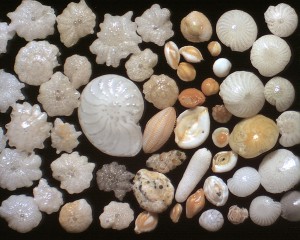
Some of the photos below are from the Foraminifera.eu Project
| |

|
Robert M. Kleinpell - No discussion of San Joaquin Valley microfossils is complete without mention of Dr. Robert M. Kleinpell (1905-1986), who did much of the pioneering work on California biostratigraphy. He spent the early part of his career in the oil industry, was a prisoner of war from 1941 to 1945 in the Phillipines, and was a professor of Paleontology from 1946 on at the University of California at Berkeley. His 1938 book on the Miocene Stratigraphy of California is the authoritative reference on the subject. Kleinpell is a pioneering geologist of the San Joaquin Valley. |
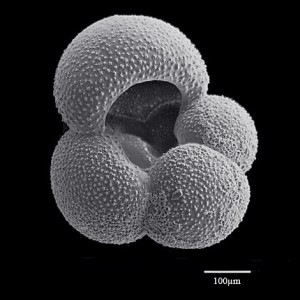
|
Calcareous Planktonic Forams have tests (shells) made of calcium carbonate, and they lived by floating on the surface of the ocean. They are more likely to be found in deep marine shales than in nearshore sandstones.
The foram on the left is a modern Globigerina Bulloides - this same species also lived in the ancient San Joaquin Valley sea. |
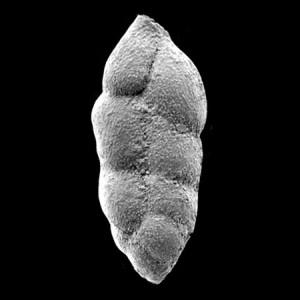 |
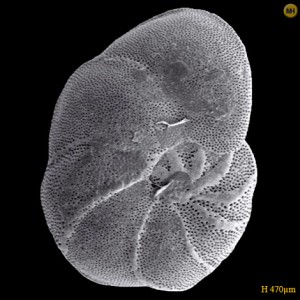
Calcareous Benthic Forams have tests (shells) made of calcium carbonate, and they lived on the bottom of the sea in nearshore settings. As they are the forams most likely to be found in ancient sediments of the San Joaquin Valley, they are used more frequently for dating marine rocks in the valley than other foram varieties.
The foram shown on the left is a modern Bolivina seminuda - similar species of the same genus lived on the bottom of the ancient San Joaquin Valley sea. Shown on the right is a modern Valvulinaria floridana, which had an ancient counterpart known as V. californica that lived on the ancient sea floor during the time sediments of the Devilwater Sandstone and Gould Shale were deposited. |
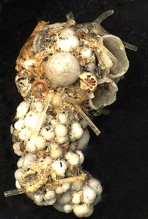 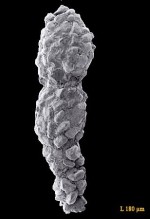
|
Agglutinated Benthic Forams, also known as arenaceous forams, have tests made of clay particles cemented together with calcium carbonate, or in a few cases with chitinous organic matter. Because their shells are more resistant to carbonate dissolution, they tend to be found in deeper water settings than forams with pure carbonate shells.
The foram shown on the far left is a modern Reophax agglutinatus, and the one to the immediate right of it is an indeterminate species of the same genus. Similar species of the same genus lived in the ancient San Joaquin Valley sea. |
Diatoms
Diatoms are single-celled plants that have shells (tests) made of opal, which is the mineral name for amorphous silica; and they are part of the many organisms that make up the marine plankton of the world's oceans. When masses of diatom-rich sediment are deposited on the deep ocean floor, the sediment eventually hardens into diatomite, which is a common rock type in the San Joaquin Valley. Diatomite is especially abundant in some areas in the Miocene-age Monterey Formation.
Below is a representative diatom. The opaline silica shell of the diatom is called a "frustule". Note the many small holes in the frustule. Those holes are called apertures, and they are good places to store oil when the rock is still in the subsurface. The only problem is that those holes are not connected, so it becomes necessary in oil fields to subject diatomites in the subsurface to a process known as hydraulic fracturing, or "fracking" as the newspapers call it, in order to connect all those holes and get the oil out.
Diatoms, like forams, were once widely used by the oil industry for biostratigraphic correlations before the advent of seismic stratigraphy. However, diatoms are a magnitude of order smaller than forams, so a scanning electron microscope (SEM) is necessary to view them in sufficient detail to be properly classified. Thus, they were not as widely used a biostratigraphic tool as forams.

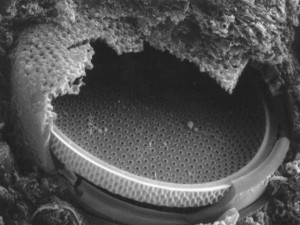 |
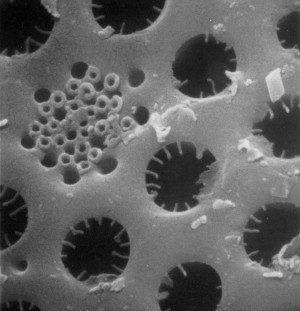
Opal A Diatomite - The individual diatoms in deeply buried diatomites get broken up, but initially the shells still have those small holes we mentioned above. Because the porosity is high, the rock can store a lot of fluid, which makes it a good oil reservoir. These rocks are called "opal A" diatomites, as they are not too badly altered and the silica is still amorphous. Note the holes in the Opal A diatomite on the right. |
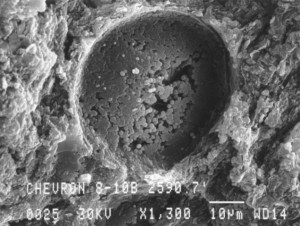 |

Opal CT Diatomite - With deeper burial the Opal A is transformed into Cristobolite and Tridymite, which are high-temperature forms of silica. The porosity is reduced, and the diatomite is no longer a good reservoir rock. Note the cristobolite and tridymite precipitating in the apertures of a diatom frustule on the right that is preserved in an opal CT diatomite from the San Joaquin Valley. |
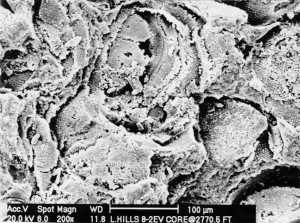 |
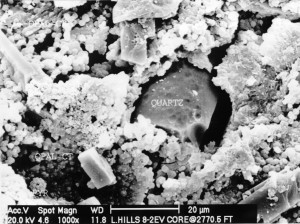
Quartz-phase Diatomite - With deeper burial, Opal CT is trans- formed into quartz, which is also referred to as chert. Although the porosity is virtually destroyed, quartz is very brittle. Thus, it fractures easily, and fractured chert can be an excellent oil reservoir. |
Radiolarians
Radiolarians are similar to diatoms in that they have shells (tests) that are made of silica, and they are so small that a Scanning Electron Microscope (SEM) is needed to study them. However, diatoms are very abundant in Tertiary-age shales of the San Joaquin Valley, whereas radiolarians are less so. Instead, radiolarians are abundant in Jurassic-age sediments of the Franciscan Formation that crop out in the coastal regions of California. The red cherts of the Franciscan Formation that are so conspicuous in the Mt. Diablo area and in the Marin headlands area on the north side of the Golden Gate bridge are made up almost entirely of the microscopic tests of radiolarians.
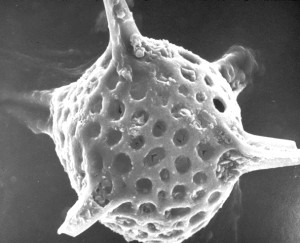
The radiolarian above was collected out of a Jurassic
limestone near Olema, on the San Andreas Fault.
Palynomorphs
Palynomorphs are microfossils made of organic material, and they include spores and pollen, as well as a type of plankton called dinoflagellates. Organic matter is not very durable, so palynomorphs are difficult to preserve in the ancient rock record. An interesting property of palynomorphs is that when deeply buried, they absorb heat from the earth and change to darker and darker shades of brown with deeper and deeper burial depths. The different shades of brown have even been calibrated into a scale called vitrinite relectance that indicates how much heat has been absorbed by the palynomprph. Vitrinite Reflectance is used to indicate if the rocks have been heated enough to change the organic matter in them into oil. However, not all organic matter in the earth can make oil. In fact, the organic matter in most palynomorphs, and from terrestrial plants in general, is more likely to turn into gas, whereas organic matter from marine plankton, algae and bacteria is needed to make oil.

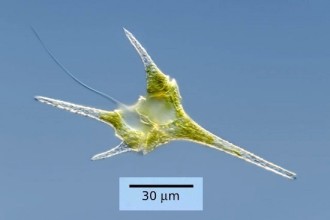
The palynomorphs on the left are spores from a fern, whereas the palynomorph on the right
is a freshwater dinoflagellate.
|
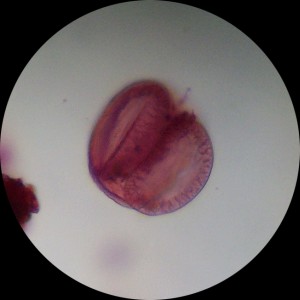
A modern grain of pollen from a pine tree is shown above. The red color indicates that the grain has not absorbed much heat, and it is said to be "thermally immature".
|
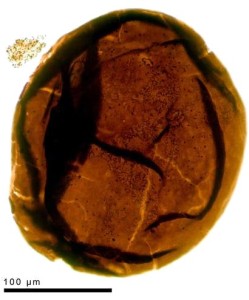
An ancient pollen grain is shown above. Here the color has changed to brown, which means that the organic matter in the grain was heated. Generally deeper burial, means more heat.
|
Shown below are pollen grains that have darkened with increasing burial depth.
The darker the grain, the more heat it has been exposed to in the earth.
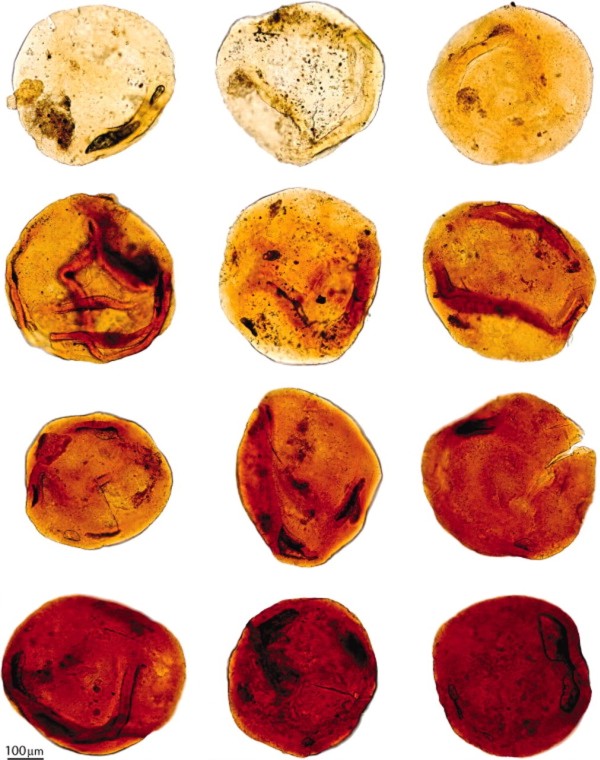
Below is a selection of palynomorphs identified in the Miocene Temblor Formation at Coalinga oil field.
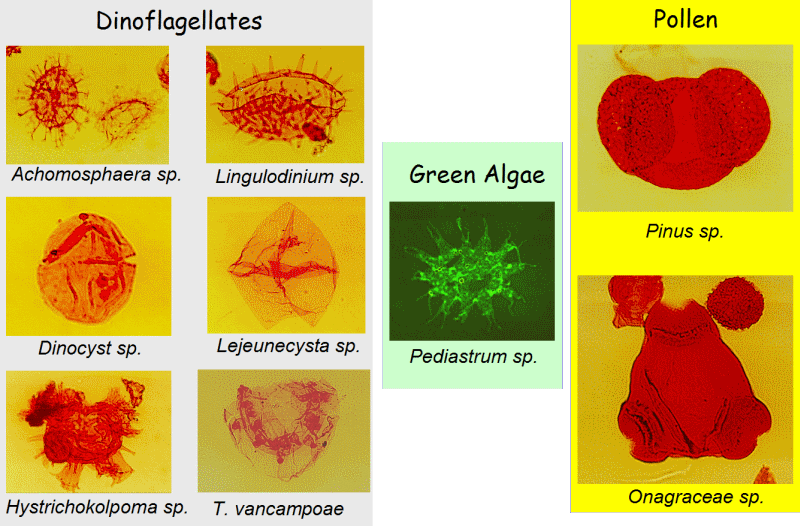
|





















